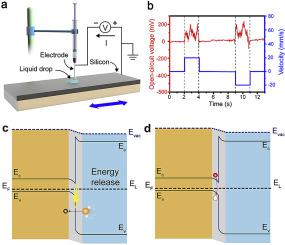Nano Energy ( IF 17.6 ) Pub Date : 2020-07-02 , DOI: 10.1016/j.nanoen.2020.105070 Shiquan Lin , Xiangyu Chen , Zhong Lin Wang

|
Contact electrification (CE) is a ubiquitous phenomenon, which occurs at almost any interfaces between any phases, but its mechanism still remains ambiguous, especially for the liquid-solid case. Here, the tribo-voltage and the DC tribo-current are generated by sliding a water droplet over a silicon surface. By varying the doping types and concentrations, the direction of the tribo-voltage and the tribo-current is found highly depending on the built-in electric field at the liquid-solid junction. It is suggested that the electrical output is induced by the triboelectric effect at the water-silicon interface, in which electron-hole pairs are excited at the silicon surface by the energy released at interface during sliding, and further separated by the built-in electric field, which is analogous to that occurs in the photovoltaic effect. The only difference is that the energy in tribovoltaic effect is provided by electron transfer across the sliding interface owing to CE and bonding interaction between liquid molecules and semiconductor surface, rather than by photon. It is demonstrated that the electron transfer exists at the liquid-solid interface, and the “two-step” model for the formation of the electric double-layer is further verified, in which the electron transfer is considered to occur in the first step when the liquid contacts a solid in the very first time, which is then followed by ion chemical/physical adsorption as the second step. The tribovoltaic effect provides a new approach for studying of the mechanism at liquid-solid CE.
中文翻译:

液体半导体界面上的摩擦伏特效应和电子转移
接触带电(CE)是一种普遍存在的现象,几乎发生在任何相之间的任何界面,但是其机理仍然是模棱两可的,尤其是对于液固情况。在此,摩擦电压和直流摩擦电流是通过使水滴在硅表面上滑动而产生的。通过改变掺杂类型和浓度,摩擦电压和摩擦电流的方向在很大程度上取决于液固结处的内置电场。建议通过在水-硅界面处的摩擦电效应来感应产生电输出,其中在滑动过程中界面处释放的能量在硅表面激发电子-空穴对,并通过内置的电隔离电场,类似于光伏效应中发生的电场。唯一的区别是,摩擦伏安效应中的能量是由于CE和液体分子与半导体表面之间的键相互作用(而不是光子)而通过滑动界面上的电子转移提供的。证明了电子转移存在于液-固界面,并进一步验证了形成双电层的“两步”模型,其中电子转移被认为是在第一步时发生的。液体在第一时间接触固体,然后第二步是离子化学/物理吸附。摩擦电压效应为研究液-固CE的机理提供了一种新途径。



























 京公网安备 11010802027423号
京公网安备 11010802027423号